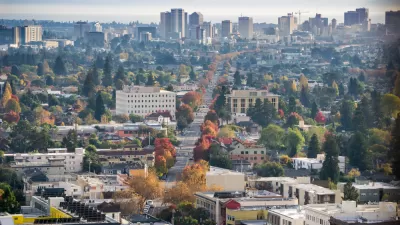A mesmerizing presentation of the narrative arc of the United State’s 20 most populated metropolitan areas reveals the evolving weave of interrelationships that make up the country's urban settlements.

Chris Cillizza shares a graph originally posted on Peakbagger.com that charts the population of the top 20 metro areas in the United States between 1790-2010.
Cillizza points out that even more compelling than the claims of superiority often made by cities near the top of the list are the stories of the cities who have tumbled down the rankings, like Detroit (once #4) and Baltimore (once #3). Baltimore, at least, recently saw its first increase in population in 50 years.
Another detail revealed by the graph is evidence of the country’s agrarian past. For instance, in 1790 Salem, Massachusetts, was #5 and Charleston, South Carolina, was #4.
FULL STORY: The 20 most populous metro areas in the United States, in 1 amazing chart

Planetizen Federal Action Tracker
A weekly monitor of how Trump’s orders and actions are impacting planners and planning in America.

Maui's Vacation Rental Debate Turns Ugly
Verbal attacks, misinformation campaigns and fistfights plague a high-stakes debate to convert thousands of vacation rentals into long-term housing.

Restaurant Patios Were a Pandemic Win — Why Were They so Hard to Keep?
Social distancing requirements and changes in travel patterns prompted cities to pilot new uses for street and sidewalk space. Then it got complicated.

In California Battle of Housing vs. Environment, Housing Just Won
A new state law significantly limits the power of CEQA, an environmental review law that served as a powerful tool for blocking new development.

Boulder Eliminates Parking Minimums Citywide
Officials estimate the cost of building a single underground parking space at up to $100,000.

Orange County, Florida Adopts Largest US “Sprawl Repair” Code
The ‘Orange Code’ seeks to rectify decades of sprawl-inducing, car-oriented development.
Urban Design for Planners 1: Software Tools
This six-course series explores essential urban design concepts using open source software and equips planners with the tools they need to participate fully in the urban design process.
Planning for Universal Design
Learn the tools for implementing Universal Design in planning regulations.
Heyer Gruel & Associates PA
JM Goldson LLC
Custer County Colorado
City of Camden Redevelopment Agency
City of Astoria
Transportation Research & Education Center (TREC) at Portland State University
Jefferson Parish Government
Camden Redevelopment Agency
City of Claremont





























